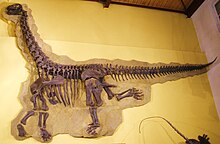Camarasaurus lewisi
| Cathetosaurus Temporal range: Late Jurassic,
| |
|---|---|

| |
| Referred specimen SMA 002 | |
| Scientific classification | |
| Missing taxonomy template (fix): | Camarasaurus lewisi |
| Type species | |
| †Cathetosaurus lewisi Jensen, 1988
| |
| Synonyms | |
| |
Cathetosaurus is a dinosaur sauropod genus that contains one species: Cathetosaurus lewisi Jensen 1988,[1] that was thought to be within the Camarasaurus genus. The holotype specimen was originally described by James Jensen and is now in the Brigham Young University collection.
The holotype specimen of Cathetosaurus lewisi is contemporary with the middle of the C. grandis age range. It is supposedly different from other species due to the bifurcation (split) of its neck vertebrae starting at a different point in the neck, and bony tendons present in the hip region. However, no other Camarasaurus specimens are well preserved enough to be sure the supposedly distinct neck vertebrae are really distinct, and bony hip tendons are also known in large, mature specimens of C. lentus and C. supremus, indicating that this difference may be a feature that changed with age.[2] This species was originally named as Cathetosaurus lewisi and later synonymized with Camarasaurus. More recent research has split the two genera again, based on the recognition of a second specimen.[3]
The diagnostic characters for Cathetosaurus are:[3]
- the pelvis is rotated anteriorly, such that the pubis projects posteroventrally, and the ischium projects posteriorly,
- lateroventrally projecting spurs in the neural spines of the last dorsals;
- posterior cervical and anterior dorsal diapophyses bearing an anterior projection lateral to the prezygapophysis.
- frontals with anterior midline projection into the nasals;
- trapezoidal supraoccipital (more expanded dorsally than ventrally),
- lateral spur on the dorsal part of the lacrimal, iv) fenestrated pterygoid;
- the large pineal foramen between the frontals.
References
- ^ Jensen, J. A., 1988, A fourth new sauropod dinosaur from the Upper Jurassic of the Colorado Plateau and sauropod bipedalism: Great Basin Naturalist, v. 48, n. 2, p. 121-145.
- ^ Ikejiri, T. (2005). Distribution and biochronology of Camarasaurus (Dinosauria, Sauropoda) from the Jurassic Morrison Formation of the Rocky Mountain Region. In New Mexico Geological Society, 56th Field Conference Guidebook, Geology of the Chama Basin (pp. 367-379).
- ^ a b Mateus, O., & Tschopp E. (2013). Cathetosaurus as a valid sauropod genus and comparisons with Camarasaurus. Journal of Vertebrate Paleontology, Program and Abstracts, 2013. 173.
